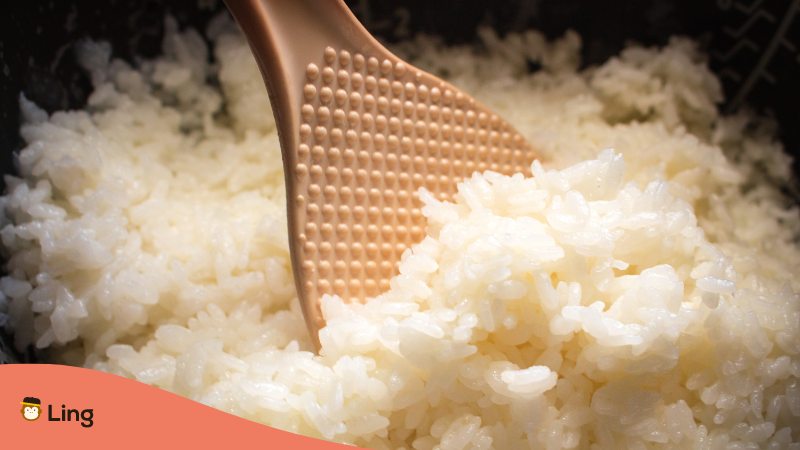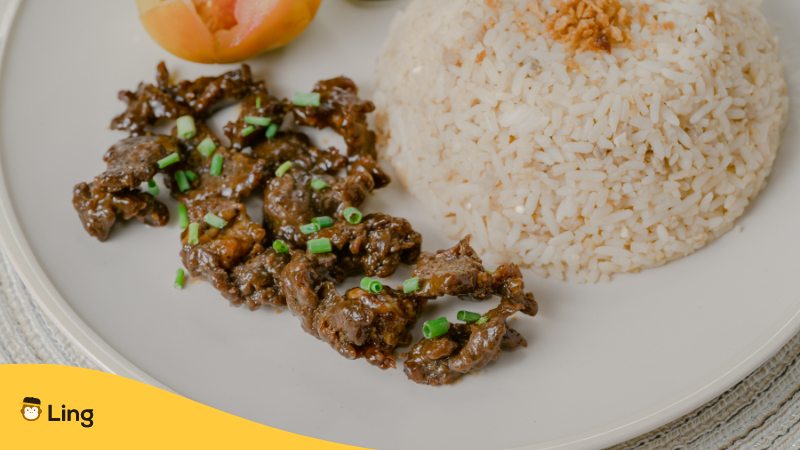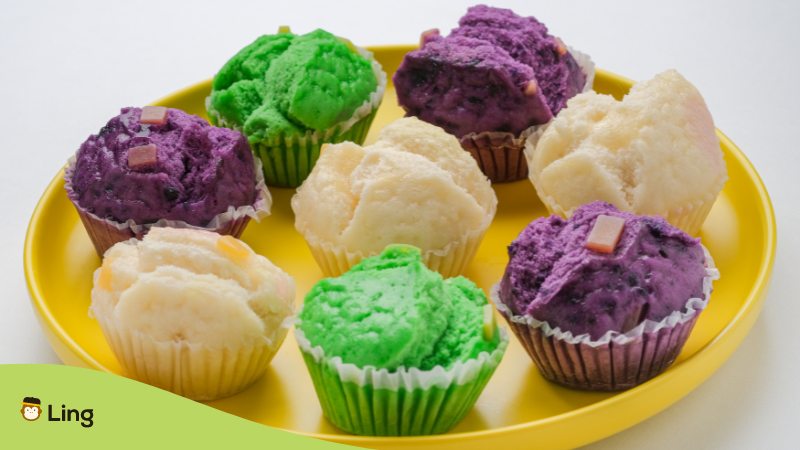Wondering about all those rice terms in Tagalog? We can’t blame you! For Filipinos, rice isn’t just a food – it’s a way of life. It’s been a part of their culture since pre-colonial times, and its importance has only grown over the years.
From the ubiquitous kanin to the more exotic terminologies like bahaw and tutong, there are so many different words in the Tagalog language related to rice in the Philippines that you must know. Let’s get to know each in this epic guide!
Table Of Contents
The Love Of Filipinos To Rice
Like most Asians, Filipinos love their rice so much that it is served at almost any time of the day. Whether eaten as a combo with a Filipino dish or as dessert, the locals have mastered cooking the perfect cup for various occasions.
And if that isn’t convincing enough, you’ll be glad to know that the country even has dedicated landmarks and institutions for this particular crop! Go up North, and you’ll witness the majestic, cascading fields of the Banaue Rice Terraces. A bit further south of Manila, you’ll see the acclaimed International Rice Research Institute, known for developing new, sustainable varieties that help prevent famine across the regions of the Philippines.
With Filipinos’ love of rice and its abundance across the country, it’s only natural that they have a wide variety of terms to describe it. Think of it like how Inuit culture in the extreme North of the US and Canada has many times for snow and ice. That’s how Filipinos have plenty of words to describe rice and its many provinces, from crop to cooked dish.

What Are The Rice Terms In Tagalog?
The English word “rice” in Tagalog is called bigas, and of course, starts off as plants carefully tended to and harvested on the fields. In Tagalog, there are two main terms for rice before they’re cooked: Palay and Bigas. And after the palay are milled and turned into bigas, the Filipino people are so clever that they can turn rice into different dishes. Here are the most common rice terms in Tagalog you must know as a language learner:
1. Palay (Pah-Lai)
The Tagalog word palay is the starting point of the rice-making process. It refers to rice in its purest form before the husk is removed from the rice plants or rice mills or gilingan in Tagalog.
2. Bigas (Bee-Gahs)
Bigas in Tagalog refers to rice in English. It’s the product of processed palay, after removing its brown husk to reveal its white grain. Compared to palay, bigas is the version ready to be cooked!

3. Kanin (Kah-Nin)
Kanin is the Tagalog term for cooked rice in its plainest form, which is often white. Nowadays, more health-conscious Filipinos are turning to brown rice, thanks to its supposedly higher nutritional value. However, white rice still reigns supreme in most Filipino households as it is easier to cook, readily available, and affordable.
4. Buhaghag (Boo-Hug-Hug)
Buhaghag literally means “not sticky” or “loose,” which is the most common way rice is prepared in the Philippines, compared to other varieties like Japanese rice. This type of rice is best for making fried rice or sinangag na kanin in Tagalog.
5. Bahaw (Ba-Haw)
The Tagalog word bahaw is a term for cooked, leftover rice. Make no mistake, though, because bahaw is far from spoiled and is often placed in the fridge. The next day, one can use it to whip up other dishes, like the favorite breakfast food known as sinangag combined with egg and other Filipino breakfasts.
6. Malata (Muh-Lah-Ta)
Malata describes undercooked rice, one with too much water placed in the rice cooker and making it mushy. Rice that’s malata is not desirable and is often discarded. But take note that it’s not because it’s malata; it’s useless. No. This type of cooked rice is best for young ones like babies and even people having difficulty chewing food.
7. Am (Ahm)
Am is the water on top of a boiling rice when being cooked. While it’s often discarded today, am was once a widespread (and now antiquated) substitute for breast milk, particularly for babies living in rural areas.
8. Tutong (Too-Tohng)
The Tagalog rice term tutong refers to scorched rice stuck to the bottom of a pot or a rice cooker. It’s a common problem for inexperienced cooks and can be frustrating to remove. But that doesn’t mean Filipinos don’t eat tutong. In fact, tutong is a favorite among Filipinos, especially when accompanied by a coffee.
9. Malagkit (Mah-Lahg-Keet)
While Filipinos mostly prefer their rice prepared the buhaghag way, specifically for breakfast, lunch, and dinner, they prefer to use malagkit when they want to satisfy their sweet tooth. Malagkit is a sticky variety of rice perfect for cooking traditional Filipino desserts like champorado and the Filipino version of paella.
Learning Tagalog is fun, right? But what if I tell you that you can learn 60+ more languages in a fun and easy way? You can do so with the Ling app! It’s available on Google Play and the App Store so try and see for yourself!

Popular Filipino Dishes That Use Rice
Are you ready to indulge in some mouth-watering Filipino cuisine? Well, get your taste buds ready because we’ve got some amazing Filipino dishes to share with you that will make you fall in love with rice again! Whether you’re a long-time rice enthusiast or just starting to appreciate its delicious versatility, the Filipino dishes we rounded up below are sure to impress.
Sinangag (See-Nuh-Nguhg)
Just like I mentioned earlier, sinangag is fried rice and is a staple part of Filipino breakfast. Filipinos often use bahaw, or leftover rice, to make sinangag and sprinkle it with salt and bits of crushed garlic to add flavor.
Silog (See-Lohg)
Silog is a portmanteau (word or words blending the sounds and combining the meanings of two others) of the words sinangag (fried rice) and itlog (egg). It refers to several kinds of breakfast dishes and is often served with a sunny-side-up egg and a side of meat, such as beef, pork, or chicken.
Tapsilog, for example, is a silog made with beef tapa, a dried, garlicky beef similar to jerky, fried rice, and egg. Tocilog, on the other hand, is often made with tocino (a sweet, cured pork), together with fried rice and egg.
Lugaw (Loo-Gahw)
The Tagalog word lugaw means rice porridge in English and is a popular Filipino comfort food often served when you’re sick or feeling cold. It is often garnished with green onions and garlic bits.
Kakanin (Kah-Kah-Neen)
Kakanin is a broad term for desserts made with malagkit, or the sticky variety of rice. They are usually made from glutinous rice, coconut milk, and sugar. Popular types of kakanin include bibingka, biko, and puto.
Bibingka (Bee-Bing-Kah)
Bibingka is a traditional rice cake made with a mixture of rice flour, coconut milk, and brown sugar. The mixture is baked in a clay pot, often topped with grated coconut and salted egg, and lined with pandan leaves at the bottom. Bibingka is usually served during the Christmas season.
Biko (Bee-Koh)
Biko is another popular kakanin, or sticky rice dessert, served as a dessert or snack. It is often topped off with a caramel-like mixture of coconut and sugar called latik.
Puto (Pooh-Toh)
Please don’t get confused! Unlike the less-than-flattering term in Spanish, puto is a type of kakanin made with rice flour and steamed in Tagalog. While often served plain, it can also be flavored with ingredients like cheese or ube, a type of purple yam.

What Are The Common Types Of Rice In The Philippines?
Filipinos don’t settle for just one kind of rice. You’ll find everything from fragrant basmati to sticky rice meant for desserts.
Most rice comes from a single plant species. Japonica rice (with short, sticky grains) is used in Japanese or Korean dishes, while Indica rice (with long grains that cook up fluffy) is a favorite in the Philippines and other tropical regions. Here are some popular options you’ll find in the Philippines, with ideas on how to enjoy them:
- Basmati Rice: Long, fragrant grains perfect for curries and saucy dishes like curry.
- Jasmine Rice: A Southeast Asian favorite, shorter and even more fragrant than basmati. Great for fried rice!
- Japanese Rice: Short, sticky grains – the foundation of sushi and onigiri.
- Arborio Rice: Italian rice known for its creaminess – a must-have for risotto.
- Bomba Rice: This Spanish rice is super absorbent and ideal for flavorful dishes like paella.
- Dinorado: This proudly Filipino rice is popular in the province of Mindoro. It is long-grained, fragrant, and slightly sticky. While seen as a special occasion rice, it’s delicious every day, especially with flavorful ulam.
- Sinandomeng: A traditional and well-loved Filipino variety, known for its aroma and slightly sticky texture. Perfect for everyday meals!
So what’s the difference? It’s all about processing! White rice is the most refined, while brown, red, and black rice retains more of those healthy outer layers. Grain length also matters—long grains tend to stay separate when cooked, while shorter grains get stickier.
How Are Rice Processed In The Philippines?
In the Philippines, rice, or bigas, is more than just food – it’s life. But have you ever wondered how those tiny grains of palay from the fields turn into the fluffy white rice we eat every day? Here’s the amazing story:
- Preparing the Ground: The hot sun beats down as Filipino farmers begin their work. Sometimes, they have a gentle giant helping them – the carabao or kalabaw in Tagalog. This strong animal pulls the plow, its hooves churning the soil until it’s soft and perfect for planting. In some places, farmers carefully shape the land into paddies, building up little walls of soil that will hold precious water for the rice.
- Picking the Perfect Seeds: Farmers don’t just use any rice! They might choose classic sinandomeng and dinorado, or other varieties known to grow well in their specific soil and climate. Each tiny seed holds the promise of a future harvest.
- Caring for the Plants: Rice plants need lots of water! Farmers keep a close eye on their fields to make sure the paddies are always flooded. They might add special nutrients to the soil to help the rice grow strong. All the while, they keep watch for weeds or insects that could try to damage the rice’s food.
- Harvest Time! Over time, the fields turn from green to a beautiful golden color – that means it’s harvest time! Farmers may use sickles to carefully cut the rice by hand, or in some places, bigger machines help get the job done faster.
- Drying Under the Sun: Freshly harvested rice has lots of moisture, so it needs to dry. Farmers spread it out in the sun—on big mats, in courtyards, or even sometimes along the roadsides. The bright sunshine gets the rice ready for the next step.
- Shedding the Husks: Now it’s off to the rice mill! Here, special machines gently remove each grain’s hard outer shell, called the ipa. And just like that, it’s the bigas we know and love! Some rice stays as is, while other grains undergo a bit of polishing to become extra shiny, creating puting bigas or white rice.
- Rice Travels Everywhere: The rice is carefully packed into sacks, ready to start its journey. You’ll find it in bustling Filipino markets, small stores in every town, and eventually, in kitchens all across the Philippines!
The Bottom Line
Rice is a huge deal in the Philippines. It’s in almost every meal—think of that garlicky sinangag at breakfast or a cozy bowl of lugaw when you’re feeling under the weather. The fact that Filipinos have so many rice terms in Tagalog shows how important it is to them. It’s about tradition, hard work, and simply enjoying a good meal.
So the next time you have rice on your plate, remember everything it took to get there—the farmers, the sunshine, and all the love poured into growing it. Rice is the taste of the Philippines, plain and simple.
Updated By: Jefbeck





























































